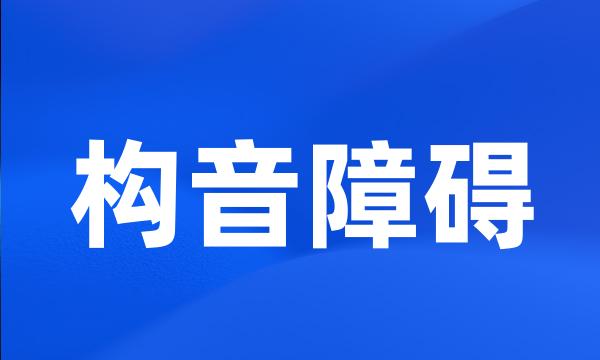构音障碍
- dysarthria;dysarthrosis
 构音障碍
构音障碍-
方法:6例长期海洛因吸入患者,在出现共济失调、构音障碍或昏迷状态后行头部MR检查,对照神经解剖断面,明确海洛因中毒引起中枢神经系统破坏的部位、范围。
Method : 6 cases presenting ataxia , dysarthria or coma due to long term heroin inhalation underwent the brain MR examination . The location and range of the injury in central nervous system were defined .
-
经过治疗可使CK值降低,还可改善患者的肌肉跳动、吞咽困难、舌肌颤动症状,使肌肉萎缩、构音障碍、肌力等症状保持稳定。
The treatment can decrease the value of creatine phosphokinase , improve muscle subsultus , acataposis and lingua muscle shivering of patients , keep stable of symptoms of amyotrophy , dysarthria , muscle strength etc.
-
目的:了解功能性构音障碍(FAD)儿童的智力水平和智力结构情况,探讨FAD与语言发育的关系。
Objective : To investigate the intelligence level and its structure of children with functional articulation disorder ( FAD ), and to discuss the relationship between FAD and language development .
-
临床特征有共济失调、构音障碍,基因诊断是一种准确的诊断方法和标准,CAG重复序列数目的检测对于基因诊断和症状前诊断是一种十分有效的方法。
The clinical features of the spinocerebellar ataxia include ataxa , dysarthria , dysmetria et al . The gene diagnosis can be used as diagnostic criteria and the detection of repeats times of CAG can provide an effective way for the genetic and presymptomatic diagnosis .
-
成年起病型强直性肌营养不良患者肌强直和弛缓型构音障碍
Myotonia and flaccid dysarthria in patients with adult onset myotonic dystrophy
-
痉挛型构音障碍脑瘫患儿不同发音方法的辅音发音特点研究
The characters of consonant pronunciation in spastic dysarthria cerebral palsy patients
-
脑瘫患儿构音障碍特点与言语治疗
Characteristics of Dysarthria in Children with Cerebral Palsy and Speech Therapy
-
个性化多媒体家庭治疗儿童功能性构音障碍
Individualized multimedia family treatment in children with functional articulation disorder
-
康复生理途径治疗可以明显改善运动性构音障碍患者的交流能力。
Physiologic approach to rehabilitation can remarkably improve patient 's communication ability .
-
目的应用行为疗法提高功能性构音障碍患者的语音清晰度,提高语音治疗效果。
Objective To apply behavior therapy to increase speech intelligibility .
-
构音障碍儿童的元音偏误分析
The Analysis of Vowel Error in Children with Articulation Disorder
-
儿童功能性构音障碍的矫治及影响因素分析
Analysis of therapeutic effect and related factors in children 's functional dysarthria
-
功能性构音障碍儿童的智力水平和智力结构分析
Analysis of Intelligence Level and Its Structure in Children with Functional Articulation Disorder
-
主要观察指标:①功能性构音障碍临床特点。
MAIN OUTCOME MEASURES : ① The clinical characteristics of functional phonological disorders .
-
应用微机言语矫治系统评价卒中患者构音障碍
An analysis of stroke patients on dysarthria by microcomputer - based speech training
-
运动性构音障碍言语、声学及疗效的研究
Speech , Phonation Evaluation and Intervention Effect in Dysarthria
-
外伤后运动性构音障碍病人的早期康复训练
Early stage rehabilitation training for posttraumatic patients with dysarthria
-
断乳期饮食添加时间与儿童构音障碍相关性研究
Study on the Dependablity of the Time Added Weaning Period Diet and Children Dysarthria
-
脑血管病构音障碍的康复训练
Rehabilitation Training on Dysarthria Patients with Cerebrovascular Disease
-
构音障碍的类型决定治疗。
The type of dysarthria determines the treatment .
-
脑卒中患者构音障碍的康复治疗
Rehabilitation therapy of dysarthria in patients with stroke
-
结论在对重度构音障碍患者的训练中应注意手法治疗。
Conclusion Manual treatment should be noticed in the training for severe dysarthria patients .
-
额叶皮质灌注不足的纯构音障碍
Pure dysarthria due to frontal cortical hypoperfusion
-
功能性构音障碍语言评价及训练效果的分析
The functional phonological evaluation and an analysis of the efficacy of treatment of phonological disorders
-
有构音障碍和言语失用等,可能会与演讲失常失语。
Apraxia of speech and Dysarthria are other speech disorders that may be confused with aphasia .
-
目的:探讨功能性构音障碍临床特点及康复治疗方法。
OBJECTIVE : To explore the clinical characteristics and rehabilitation treatment methods for functional phonological disorders .
-
结论:置换音是儿童功能性构音障碍最主要的构音错误方式;
Conclusion : The main erroneous articulation pattern of functional articulation disorder in children is substitution .
-
结果临床特点:眼睑下垂、咽下困难、构音障碍,可累及四肢骨骼肌出现肌无力、肌萎缩;
Results The clinical features included ptosis , dysphagia , dysarthria and the limb weakness or amyotrophy .
-
目的探讨脑卒中所致痉挛型构音障碍的临床康复训练方法及疗效。
Objective To explore the method of rehabilitation training for post-stroke spasmodism model dysarthria and its efficacy .
-
合谷雀啄刺法治疗脑卒中后假性球麻痹构音障碍30例
Clinical Observation of Sparrow-pecking Acupuncture Needling in He-gu on Supranuclear Paralysis Dysarthria , A Report of 30 Cases
